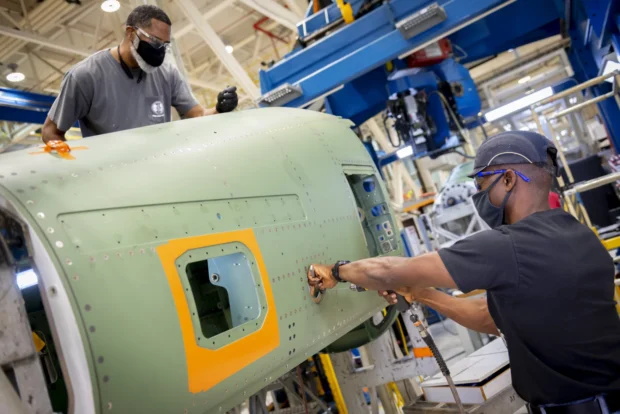HOME | ABOUT US | MEDIA KIT | CONTACT US | INQUIRE
HOME | ABOUT US | MEDIA KIT | CONTACT US | INQUIRE
Missouri’s traditional posture is that of a state insulated from deep economic swings. But underneath the surface, some significant shifts are taking place.

In the big picture, a statewide economy doesn’t come with much more stability than you’ll find in Missouri. Its diverse blend of agribusiness, manufacturing, financial and professional services, health-care and construction concerns created both vibrancy and consistency in the aggregate.
The result: An estimated $337 billion statewide GDP, placing Missouri near the dead center among U.S. states at No. 24. As we said: A picture of stability.
That does not, however, mean the Show-Me State’s economic makeup is resistant to the types of transformative change the rest of the nation has seen over the past 50 years.
Start, for example, with manufacturing. U.S. manufacturing employment at the start of 1974 was 18.78 million; by 2024, that had fallen to 12.85 million—down by a third. While that trend line was replicated in Missouri, industrial production in dollar terms didn’t fare nearly as badly. Technology has impacted all business sectors, but few have been transformed in the way manufacturing has been. Huge tech-driven productivity gains have helped keep manufacturing output comparatively stable in terms of dollars. In terms of employment? Not so much.
Nothing tells that story quite like Missouri employment figures over the past 50 years. Of nine major employment sectors tracked by the Bureau of Labor Statistics, manufacturing was the only one that saw a drop in number of working Missourians. And not by just a little: Private education and health-care, as a super-sector, more than doubled in employment over the past 50 years, not far ahead of professional services.
Still, manufacturing yielded nearly $1 out of every $8 in total state output, just over 12 percent, while employing 9.52 percent of the workforce. Total output from manufacturing was $40.46 billion in 2022, according to the BLS.
The most dramatic change has been in what are considered advanced manufacturing jobs, those far removed from the rote motions of 20th-century assembly lines. Today’s manufacturing relies on computers, programming, robotics, and the more highly educated, trained, and skilled workers to keep those systems running.
As a result of those trends, overall manufacturing employment in the state has fallen from 390,600 in 1974 to 286,800 this year.
The Bigger Picture
Across the state, the most profound changes in the economy show up where the job growth has tracked. The clear winner among sectors has been private education and health-care, which more than doubled its employee headcount since 1974, hitting nearly 528,000 today.
A close second has been hospitality, up better than 90 percent to nearly 350,000 jobs, with professional services not far behind at 383,900 jobs, up 80.83 percent. Somewhat surprising, given the huge gap between qualified workers and construction employers, that group saw workforce numbers surge 73.15 percent to 156,700.
Missouri has fared well in that category thanks in part to companies like JE Dunn Construction in Kansas City and McCarthy Building in St. Louis, each of which has established a national footprint over the past 50 years as both have surged into the nation’s Top 20 contracting firms, based on revenues.
Less robust but still recording double-digit workforce gains have been financial activities, up 38.53 percent with 190,000 jobs; other services, up 33.22 percent with 118,300 jobs; and the broad category of trade, transportation, and utilities, up only 13.77 percent, but representing the broadest category of employment—567,500 jobs.
Growth in the latter isn’t surprising, given the state’s rising prominence in the distribution and logistics sector. For decades, the state has been a focal point for rail transport, although it has also enjoyed a place in the highway-freight realm by virtue of the nearly transcontinental Interstate 70, connecting the East Coast nearly to the west.
While the massive infusion of construction spending has created hundreds of millions of additional square feet of warehouses, advances in warehousing and distribution technologies have greatly reduced the manpower needed to staff those monster locations. Thus, the more modest percentage increase in employment.
Perhaps most surprising of all is that the super-sector with the slowest employment growth has been government at all levels: up 11.7 percent to 406,800 jobs. That translates into a barely perceptible net gain of 1.6 percent in overall employment over that 50-year period.
Overall, while the state’s population has grown 28.8 percent since 1974, the number of jobs has grown by nearly 40 percent. One reason why Missouri sits at near the bottom of U.S. states with its unemployment rate of 3.8 percent.
Of course, in a state of 86,000 square miles—with nearly two-thirds of it devoted to cropland production, pastureland or woodland uses—agriculture and its downstream agribusiness will play an outsized role in the value of production, if not the total employment numbers.
Farm output in 2022 was $15.67 billion, ranking Missouri No. 13 among U.S. states. In 1974, by comparison, the inflation-adjusted figure was $15.52 billion. Thus, even as the number of farms fell from 115,000 to about 90,000, the increased output of each has risen slightly since then.
Employment: By midsummer 2024, the unemployment rate in Missouri had crept back up to 3.8 percent after hovering for months at 3.3 percent and occasionally below that. That’s significant because even at the higher end this year, the state still falls within the narrow range that many economists define as technical full employment.
More than 3.1 million Missourians are in today’s workforce, with all but 103,000 of them employed. Over the previous 21 months, construction led the way with a 5 percent increase in the workforce, pushing past 150,000 jobs. Next up was education and health services at 3.7 percent. Those numbers jump off the page for a state whose non-farm employment increased just 1.6 percentage points over that same span.